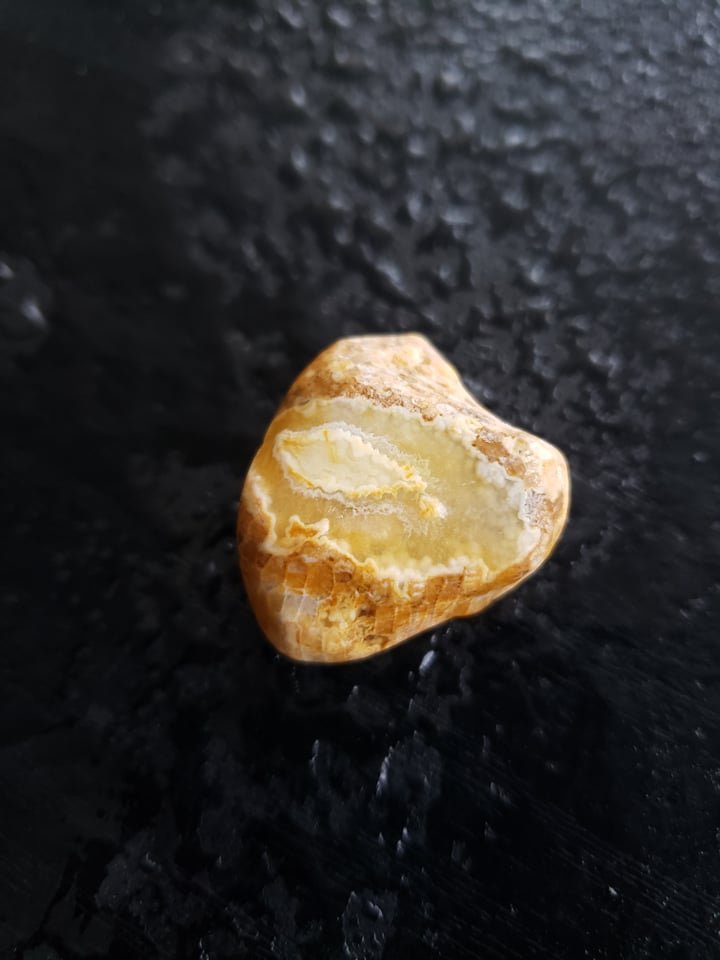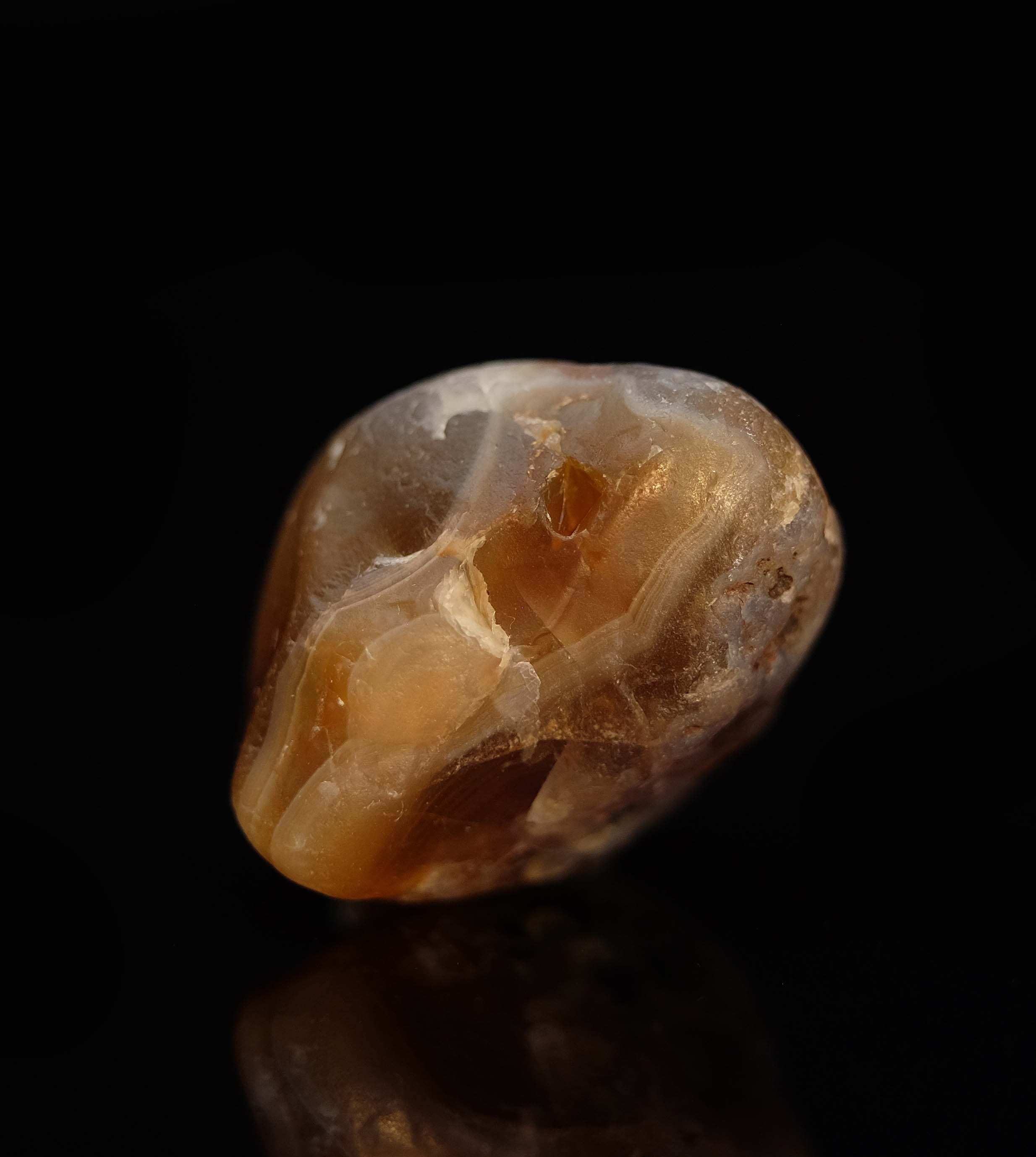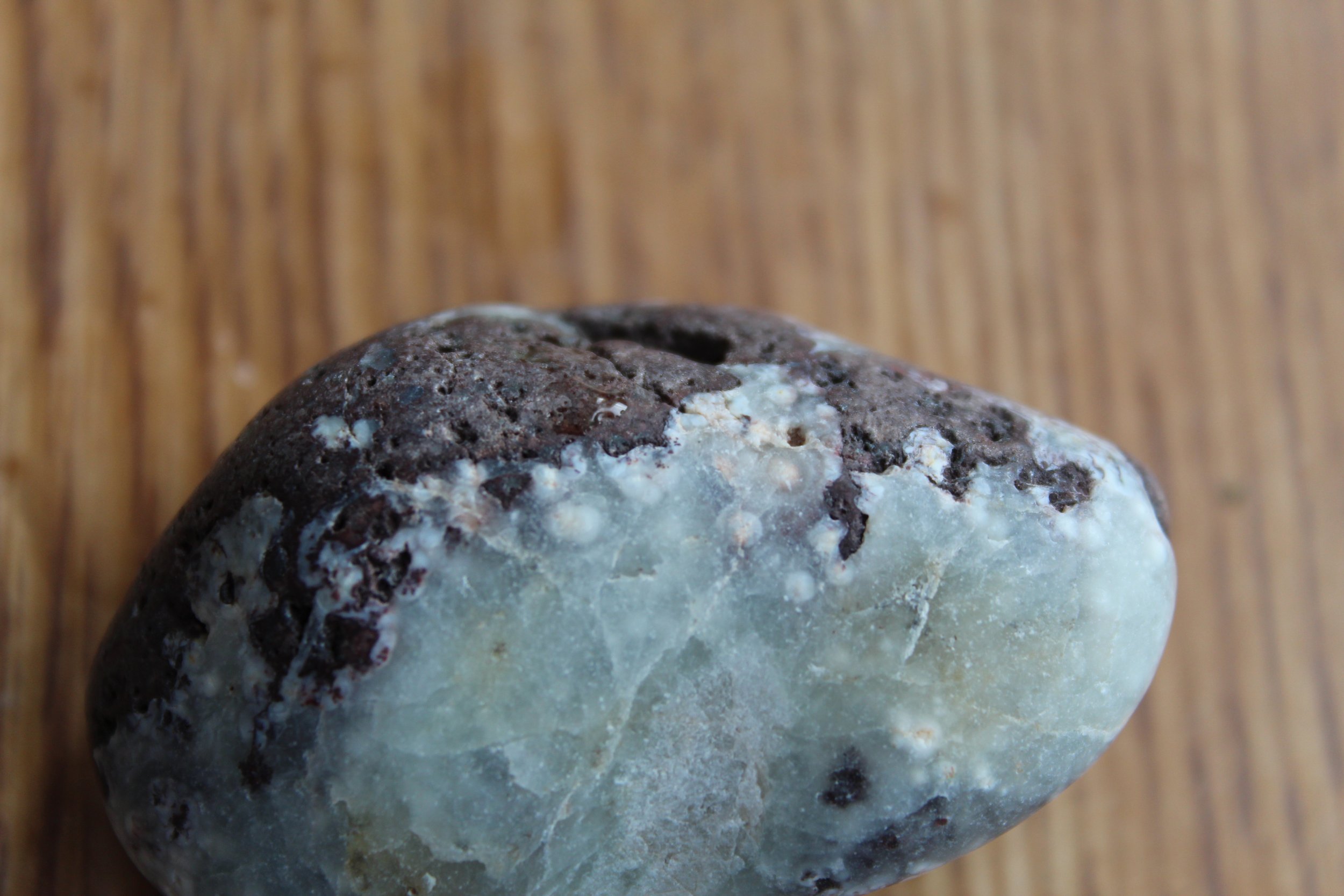Agates: Banded and Beautiful
Photo credit: Shelly Meyer, found at Whitefish Point
Agates—they’re some of the most desirable and highly sought-after stones in Michigan. Their intricate patterns, their color, and their depth come together in the most captivating way, entrancing both amateur and professional alike. What exactly are agates, though? How can I identify them and where can I find them?
JUMP TO SECTIONS IN THIS ARTICLE:
What are agates?
The definition of agate is actually quite simple: it is banded chalcedony and quartz. And that’s it. Now that we’ve established the basics, let’s talk about what that actually means. Quartz is one of the most common minerals in Earth’s crust and is arguably the most abundant at the Earth’s surface. It is a very simple mineral, with the formula SiO2; it’s literally just a silicon atom with 2 oxygens. Quartz is a crystalline mineral; that just means it forms crystals. If you’re unfamiliar with quartz, please see its mineral identification page here (coming soon).
Photo credit: Cody Wiedenbein
Chalcedony is a cryptocrystalline form of quartz. Crypto means mysterious, secret or hidden. A cryptocrystalline material is one made of crystals that are so tiny that, not only are they invisible to the naked eye, but they are even too small for the most powerful microscopes to see. It’s only partially true that chalcedony is a form of quartz, though. Technically it’s a mix of insanely tiny moganite crystals and quartz. It has a different structure from actual quartz, but with the exact same chemical composition: SiO2. For more information, see chalcedony’s mineral identification page here (coming soon).
Photo credit: Julie Truax, found at Whitefish Point
The most obvious part of an agate’s definition is banding: true agates are almost always translucent (letting through some light when you shine a light on it) and have banding- thin visible layers. Often these bands form concentric rings, though not always. The patterns can be quite wild.
Photo credit: Todd Warner
What are the types of agates in Michigan?
So the number of agate varieties in Michigan really depends on who you ask. If you ask an amateur enthusiast to number all the agate varieties for you, you’d might as well ask them to number the stars. Everybody takes a crack at inventing a name for some slight variation of a pattern in agates. Crazy Lace, Thunder Egg, Moss, Condor, Coyamito, Plume, Iris, Dandelion, Eye, Water Line, Tube, Skip an Atom, Fire, and Laguna are just a few. In fact, I completely made up one of those and I bet it’ll take you at least a several minutes on google to figure out which one was slightly more nonsense than the others! To a geologist, it’s all rather silly since these are all just slightly different patterns in the bands and colors of the banded chalcedony and quartz. If we played those games with every rock and mineral, assigning a new name to every pattern that exists, no one could possibly keep track of the billions of varieties!
If you ask a mineralogist about the varieties, though, they’re likely to take things to an even greater extreme in the opposite direction. Mineralogists can be brutal and agate… is not a mineral! It’s a pretty mix of minerals. How does the Seaman Mineral Museum and the book Mineralogy of Michigan approach agate?
The book, Mineralogy of Michigan, is unkind to agates
Does. Not. Exist. It’s just a silly cute name for quartz.
That’s a little rough and most geologists aren’t so tough on agates. We’re more likely to tell you that there are a few varieties in Michigan and beyond that, you can call agates whatever you like. Agates with a lot of red in them are popularly called Lake Superior Agates, or LSA’s. They are red because they have been stained with iron from the iron ranges. Not all red agates come from Lake Superior, so not all agates with red are Lake Superior Agates since all Lake Superior Agates must come from Lake Superior, but just remember that not all agates from Lake Superior are red, and thus not all Lake Superior agates are Lake Superior Agates. Does that make sense? Confusing? Now you know why we geologists roll our eyes at the nonsense!
Photo credit: Julie Truax, found near Manistee
By my definition, there are ordinary agates and cold water agates in Michigan. Ordinary agates are those that are best known- they have various colors and bold banding and can be any size. They can be found anywhere in Michigan, but they’re much more common as you go north and most common along Lake Superior.
Photo credit: Cody Wiedenbein, cold water agate from near Tawas
Cold water agates are a different breed. These form in limestone and they have a special name because they are thought to form in a special way (we’ll talk about that in a moment). These form in limestone and are almost always completely colorless, composed of clear and milky white bands. They’re found abundantly in Southern Michigan where limestone is common and they’re often quite small. While lacking the bold colors of their northern cousins, they can still be remarkably beautiful.
Beyond that, as far as this geologist is concerned, you can call your agate variety whatever you like. There’s no commission or organization for that, it’s simply about what names catch on and which ones don’t. I even named my own agate variety: the Elvis Agate.
Aside: The Elvis Agate is named in honor of Dr. Jackie Huntoon, who once explained that she named a sedimentary unit in Utah “the Elvis Formation.” This was not long after the death of Elvis and at a time when there were Elvis “sightings” every day in the tabloids and all sorts of conspiracies. She and a colleague were working and noticed a small and rather insignificant rock unit that had never been described at a location. And then they noticed it at another spot… and another. Suddenly, they realized that this layer of rock wasn’t just in one spot, it was everywhere and it became a running joke with them: the more you want to see it and the more you look for it, the more you see it. Like sightings of Elvis. So as a joke, they named it the Elvis Formation and submitted it to the humorless USGS for inevitable rejection… but the USGS had just taken huge funding cuts and the few employees left apparently didn’t care anymore. And so the Elvis Formation got its name; the more you want to see it, the more you see it wherever you go!
The Elvis Agate is inspired by that story. It’s a fun label to apply to pieces folks show you. Is this an agate? If you squint your eyes real hard and look at it from this angle under this particular light, you can kind of see it… That’s an Elvis Agate. It’s a piece where you can only see that it’s an agate if you really really want it to be an agate!
Photo credit: Cody Wiedenbein, master Elvis agate hunter
How do they form?
Interestingly, for such a desirable stone, agates have not been well studied at all. There are probably two main reasons for this. First would be the disdain mineralogists sometimes show for this “not a mineral.” The second is that there’s no economic reason to study it. No one has ever gotten rich from an “agate mine” and agates won’t lead you to gold or silver or oil or platinum. They’re just… kinda out there and pretty. It seems that on the rare occasion someone wants to study agates, the most important question they have to answer is… why bother?
For a long time, there was only a single model for the formation of agates, even though it didn’t fit a lot of examples well. Then cold water agates were discovered and a second model was proposed… and that kind of explains the cold water agates, but there’s clearly still a lot to be learned. Ok, let’s not get ahead of ourselves. What is the standard model for how agates form?
Agates are thought to form in vesicles in volcanic rocks. A vesicle is a hollow gas bubble that was trapped within flowing lava. Lava flows are often chock full of these vesicles and as mineralized water begins flowing through the rock, these hollow spaces fill with water and minerals begin filling in the empty space. Once that space is filled, that vesicle is called an amygdule.
Photo credit: Craig McClarren. Partially-formed agate with prehnite and other minerals in basalt vesicles from the Keweenaw
Minerals need something to cling to as they form. If you can recall back to grade school, perhaps you remember the sugar candy experiment where you take a glass of hot water that is overly concentrated with sugar and you insert a string or a stick and as the water cools, sugar crystals begin clinging to it and you end up with a pretty flavorless crystalline sugar stick after a few days. Well, that’s actually a universal behavior for mineral growth. The highly mineralized water that fills in the hollow vesicle begins depositing minerals along the walls of the vesicle. As the composition of the water changes, bands begin forming as concentric rings of mineral form along the vesicle walls. A band of chalcedony forms and as the chemistry of the water changes, a band of quartz is deposited and then the water is refreshed with more mineralized water and perhaps a red iron-rich layer of chalcedony is deposited, followed by a colorless chalcedony, followed by quartz… the variations and possibilities are virtually endless.
Photo credit: Craig McClarren. From the Keweenaw. Retains the original shape of the vesicle and the mineral rind from which the agate grew
And so this is the way we have known that agates form for years and years now. Agates only form in the vesicles of volcanic rocks by the process described above, end of story… except for those dang cold water agates that seem to be fairly unique to Michigan. These are colorless agates that are found in limestone. So… after finally acknowledging that they do in fact exist, a new model was proposed for these weirdo agates: they must have formed in cracks and cavities- hollow spaces- in the limestone and dolostone rocks and formed in pretty much the exact same way as the volcanic rock agates.
Photo credit: Tonda Waterstredt, cold water agate uncut and cut
Alright, well that’s great—adapting the standard model of agate formation to limestone cold water agates didn’t take too much work and all that much study, which is convenient, so what a relief that we know exactly how all agates form and there’s nothing left to learn. Except that we’ve forgotten completely about petrified wood, particularly agatized wood.
Photo credit: Tonda Waterstredt, cold water agate in fossil coral
Most mineralogists will tell you that agate needs a hollow space to fill and that it is not a true replacement mineral, but then you have petrified wood where decaying wood was replaced by chalcedony to form agatized wood. So ok, agate can only form in hollow spaces in volcanic rocks and hollow spaces in limestone and can replace organic matter that is not mineral, but it can’t replace other minerals. Except that you can get agatized fossils, so only hollow spaces in volcanic rocks and limestone and it can replace decaying wood and it can replace minerals in shells and fossils, but that’s it! That’s it! That’s it! That’s it! No more!
Except that there are bizarre examples that can be found along the Great Lakes. Consider, for example, this porphyritic rhyolite that was found by a member of our group.
Photo credit: Terry Smith, displaying bizarrely agatized porphyry minerals in a rhyolite
The porphyry minerals are banded chalcedony and quartz! Agate does not form porphyry minerals; these minerals have been altered and replaced with banded chalcedony and quartz. How? I don’t know. Frankly, nobody knows and it hasn’t been studied. It would seem that the very simple models that are currently out there are simply failing to explain what we see! Or consider the agate in the limonite-bearing banded iron formation below, which by current models should not exist!
Photo credit: Cletus Erny, from near L’Anse. Unexpected agate in bands of limonite-bearing banded iron formation
So how exactly do agates form? There are a lot of geologists and professionals out there who will tell you that we know exactly how agates form. I wish I could be one of them, but it’s quite exciting to report that there is still much to learn and that our understanding of agates and their formation is likely to expand dramatically over the next several decades!
Identifying an agate
This topic always seems so basic and easy to me, as a geologist, but I’m clearly biased and in the minority. One of the most common questions asked by members of Michigan Rockhounds is “is this an agate” to which the answer is “no” at least half the time. Obviously, we geologists need to make the simple task of identifying an agate more obvious. So here’s the simple version: there are only 2 questions.
Question 1: Is there banding?
If there is no clear banding, it is not an agate. What do we mean by banding? There should be lines or layers of mineral, usually in concentric rings but sometimes in pretty wild and unusual patterns. If there are no repeating rings or layers or bands, then it is not banded and you can immediately conclude that it’s not an agate.
Photo credit: Julie Truax, from Manistee
If there is banding, we move on to…
Question 2: Is it translucent?
It can be tough to determine, but by most definitions, agates should be at least somewhat translucent. When you shine a light on it, at least some of that light should be able to pass through. If you hold the stone up to the sun or a light bulb, you should see at least some light passing through. If it’s completely opaque, then it could be a very interesting mineral, but it’s probably not an agate.
Photo credit: Todd Warner, illustrating translucence when held to light
Now, this can be trickier than it sounds. Even very clear minerals can look opaque if they are thick enough or if there is dark material inside or behind them. At the same time, even opaque minerals can be translucent if sliced thinly enough- there’s a whole science of studying the way thin sections of minerals interact with light under a microscope. So figuring out if it’s translucent can be trickier than it sounds, but if it looks like light could pass through it or if you can see inside it a bit, then yeah: it’s translucent.
An Additional & Important Trick:
WET YOUR STONE
WHEN HAVING A CLOSE LOOK AT IT!
Agates are often only really obvious when cleanly cut or polished. A rough surface- even microscopically rough- can really hide both translucency and banding. So before you decide what you’ve got isn’t an agate, give it a rinse and another look!
Photo credit: Craig McClarren, illustrating improved appearance of unpolished agate by wetting it
If your answer to both of those questions is yes — it has banding and it’s also translucent — then congratulations:
YOU’VE GOT AN AGATE!
Where can I find them?
Agates can be found all over Michigan, but it’s really not random. Many rocks that have been scattered by the ice sheets that once covered our state are distributed randomly because they were pretty randomly dropped all over after they were picked up across Canada. Many of our colorful agates, though, actually came from lava rocks in the Upper Peninsula. Thus, while agates can be found scattered across the Lower Peninsula thanks to that glacial action, your odds for finding them increase dramatically as you approach the ancient volcanic rocks along the western shores of Lake Superior. Along that shore, from Minnesota to especially the Keweenaw, agates get really abundant and they remain more common at least until around Whitefish Point. As you get away from those volcanic source rocks and into the sedimentary rocks of the eastern UP and southern shores along Lake Michigan, agates become much less common. And generally speaking, the further south you get, the less common they become. By the time you reach mid-Michigan, finding a colorful traditional agate has become really really rare. But then, in the limestones of the southern UP and Lower Michigan, suddenly you can start finding the colorless cold water agates that don’t exist along the shores of Superior.
Photo credit: Todd Warner
Now, when I talk about agates being abundant in some places, I want to temper your expectations: I’m not talking about glittering beaches of agate as far as the eye can see. When I talk about beaches with abundant agate, I mean that if you park yourself and search for 20 or 30 minutes, you’ve got a good chance of maybe finding one- more if you know what you’re doing.
Agates come from volcanic rocks and limestone, so there are probably far more on land still buried within rocks than there are along the shores, but they are very hard to notice unless they’ve already been worn and polished by the waves of the shore. An agate with a rough surface often looks rather ugly and you can’t see banding in it. Thus, while most agates are probably inland and buried within rocks, your only real chance for actually finding them is on the shorelines and that’s where you need to go.
Photo credit: Craig McClarren, broken rough agates
As for me, I’m pretentious. I don’t like to hunt the shores for rocks because it’s all so incredibly random. I’d rather find deposits of whatever I’m looking for in the woods or at an abandoned quarry. But for agates, I make a big exception. I love hunting the shore for agates. I feel like I’ve struck gold every time I find one and if you’ve never hunted for agates along the shore, you’re really missing out. Get out there, find some and share those pictures of your treasure with the group!
Tips for finding your own agates
✓ Find your perfect shorE.
Pick a rocky beach that has no nearby cliffs or steep hillsides. A beach on or near basalt can be very promising. Avoid sandy beaches and shores near large rivers or dunes.
✓ Choose the perfect weather.
Sunny is best for spotting agates and a warm day is always more pleasant. Windy days and large waves can be dangerous and will make finding agates along the waterline far more difficult or even impossible. Agates are less likely to catch the eye under clouds or poor lighting.
✓ Look for the right colors.
Beige, red and maroon are common colors for agates on Lake Superior; white is more common to the south, but you can also get white agates in the north. Any stone that appears to be translucent should be inspected.
✓ Look for unusual patterns, especially banding.
Look for any interesting patterning. An unusually splotchy rock may have agate as well, so pick it up and turn it over.
✓ Look for the shine.
Agates on the shore typically have somewhere between a glassy and waxy sheen so keep an eye out for those.
✓ Look in areas that are less likely to be picked over.
Less frequented (legal) beaches are great but also get in the water if it’s safe for you to do so. Many people don’t and a lot of great agates can be found in knee-deep water that people don’t venture into. Don’t put yourself in danger trying that, though, if your health or the weather makes that a risk.
✓ Pick a spot to park.
Many people walk a beach quickly, assuming that their odds improve by covering a lot of ground. That is a great way to miss almost everything, though. You’re more likely to find something by calmly finding a nice spot, searching it thoroughly, and then scooting a few feet over to look some more.
✓ Dress for your activity.
Dress to stay warm if the weather is cold or you’re going into the water, cover up to protect yourself from the sun.
✓ Be patient.
Even in areas where agates are “common” you won’t be coming home with a bucketful. Even a handful is an unreasonable expectation. Finding agates should be a calm and relaxing activity; enjoy the hunt and consider actually finding one to be a wonderful occasional perk. If you’re patiently looking for stones of the right color, shine, patterns, and translucency on a nice day in a less picked over part of a less popular rocky beach in an area known for agates away from local cliffs and hills, you’re very likely going to come home with something special.


























